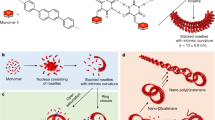Abstract
Supermolecules consisting of interlinked ring-like molecules (catenanes)1 are an interesting target for chemical synthesis both for their intrinsic interest as non-covalently bound but robust assemblies and because of the perspective they offer on materials chemistry2. Catenanes have been prepared by metal-ion templating3,4 and self-assembly through other non-covalent interactions5,6,7,8,9,10,11,12. Here we report the synthesis of a catenane composed not of two interlocking rings but of two cages. This structure is prepared by metal-mediated self-assembly13,14,15. The framework of each cage is assembled from five components: two tridentate ligands held together with three metal ions. Because each cage framework can bind an aromatic ring, two cage units will bind one another during their assembly process through the formation of a quadruple aromatic stack, giving rise to the ten-component interlocked supermolecule16,17.
This is a preview of subscription content, access via your institution
Access options
Subscribe to this journal
Receive 51 print issues and online access
$199.00 per year
only $3.90 per issue
Buy this article
- Purchase on Springer Link
- Instant access to full article PDF
Prices may be subject to local taxes which are calculated during checkout




Similar content being viewed by others
References
Wasserman, E. The preparation of interlocking rings: a catenane. J. Am. Chem. Soc. 82, 4433–4434 (1960).
Amabilino, D. B. & Stoddart, J. F. Interlocked and intertwined structures and superstructures. Chem. Rev. 95, 2725–2728 (1995).
Dietrich-Buchecker, C. O., Sauvage, J.-P. & Kintzinger, J.-P. Une nouvelle famille de molecules: les metallo-catenanes. Tetrahedr. Lett. 24, 5095–5098 (1983).
Sauvage, J.-P., Dietrich-Buchecker, C. O. & Chambron, J.-C. in Comprehensive Supramolecular Chemistry Vol. 2(eds Sauvage, J.-P. & Hosseini, M. W.) Ch. 2, 43–83 (Pergamon, Oxford, (1995).
Ashton, P. R. et al . A[2]catenane made to order. Angew. Chem. Int. Edn Engl. 28, 1396–1399 (1989).
Hunter, C. A. Synthesis and structure elucidation of a new [2]-catenane. J. Am. Chem. Soc. 114, 5303–5311 (1992).
Vögtle, F., Meier, S. & Hoss, R. One-step synthesis of a fourfold functionalized catenane. Angew. Chem. Int. Edn Engl. 31, 1619–1621 (1992).
Fujita, M., Ibukuro, F., Hagihara, H. & Ogura, K. Quantitative self-assembly of a [2] catenane from two preformed molecular rings. Nature 367, 720–723 (1994).
Johnston, A. G., Leigh, D. A., Pritchard, R. J. & Deegan, M. D. Facile synthesis and solid-state structure of a benzylic amide [2] catenane. Angew. Chem. Int. Edn Engl. 34, 1209–1212 (1995).
Hamilton, DG. et al . Tandem hetero-catenation: templating and self-assembly in the mutual closure of two different interlocking rings. J. Am. Chem. Soc. 120, 1096–1097 (1998).
Batten, S. R. & Robson, R. Interpenetrating nets: ordered, periodic entanglement. Angew. Chem. Int. Edn Engl. 37, 1460–1494 (1998).
Drain, C. M., Nifiatis, F., Vasenko, A. & Batteas, J. D. Prophyrin tessellation by design: metal-mediated self-assembly of large arrays and tapes. Angew. Chem. Int. Edn Engl. 37, 2344–2347 (1998).
Baxter, P. N. W. in Comprehensive Supramolecular Chemistry Vol. 9(eds Sauvage, J.-P. & Hosseini, M.W.) Ch. 5, 165–211 (Pergamon, Oxford, (1996).
Fujita, M. Self-assembly of [2]catenanes containing metals in their backbones. Acc. Chem. Res. 32, 53–61 (1999).
Fujita, M. Metal-directed self-assembly of two- and three-dimensional synthetic receptors. Chem. Soc. Rev. 27, 417–425 (1998).
Dietrich-Buchecker, C., Frommberger, B., Lüer, I., Sauvage, J.-P. & Vögtle, F. Multiring catenanes with a macrobicyclic core. Angew. Chem. Int. Edn Engl. 32, 1434–1437 (1993).
Ashton, P. R. et al . An interwoven supramolecular cage. Angew. Chem. Int. Edn Engl. 36, 59–62 (1997).
Fujita, M., Aoyagi, M., Ibukuro, F., Ogura, K. & Yamaguchi, K. Made-to-order assembling of [2]catenanes from palladium(II)-linked rectangular molecular boxes. J. Am. Chem. Soc. 120, 611–612 (1998).
Ibukuro, F., Kusukawa, T. & Fujita, M. Athermally switchable molecular lock. Guest-templated synthesis of a kinetically stable nano-sized cage. J. Am. Chem. Soc. 120, 8561–8562 (1998).
Jorgensen, W. L. & Severance, D. L. Aromatic-aromatic interactions: free energy profiles for the benzene dimer in water, chloroform, and benzene. J. Am. Chem. Soc. 112, 4768–4774 (1990).
Hunter, C. A. & Sanders, L. K. M. The nature of π-π interactions. J. Am. Chem. Soc. 112, 5525–5534 (1990).
Fujita, M. et al . Self-assembly of ten molecules into nanometre-sized organic host frameworks. Nature 378, 469–471 (1995).
Hasenknopf, B., Lehn, J.-M., Kneisel, B. O., Baum, G. & Fenske, D. Self-assembly of a circular double helicate. Angew. Chem. Int. Edn Engl. 35, 1838–1840 (1996).
Fujita, M., Nagao, S. & Ogura, K. Guest-induced organization of a three-dimensional palladium (II) cagelike complex, a prototype for “induced-fit” molecular recognition. J. Am. Chem. Soc. 117, 1649–1650 (1995).
Author information
Authors and Affiliations
Corresponding author
Supplementary information
Supplementary Information
Supplementary Information (PDF 25 kb)
Rights and permissions
About this article
Cite this article
Fujita, M., Fujita, N., Ogura, K. et al. Spontaneous assembly of ten components into two interlocked, identical coordination cages. Nature 400, 52–55 (1999). https://doi.org/10.1038/21861
Received:
Accepted:
Issue Date:
DOI: https://doi.org/10.1038/21861
This article is cited by
-
Catenated covalent organic frameworks constructed from polyhedra
Nature Synthesis (2023)
-
Dimeric and trimeric catenation of giant chiral [8 + 12] imine cubes driven by weak supramolecular interactions
Nature Chemistry (2023)
-
Hierarchical communication of chirality for aromatic oligoamide sequences
Nature Communications (2021)
-
A cyclic bis[2]catenane metallacage
Nature Communications (2020)
-
Strategies for binding multiple guests in metal–organic cages
Nature Reviews Chemistry (2019)
Comments
By submitting a comment you agree to abide by our Terms and Community Guidelines. If you find something abusive or that does not comply with our terms or guidelines please flag it as inappropriate.



